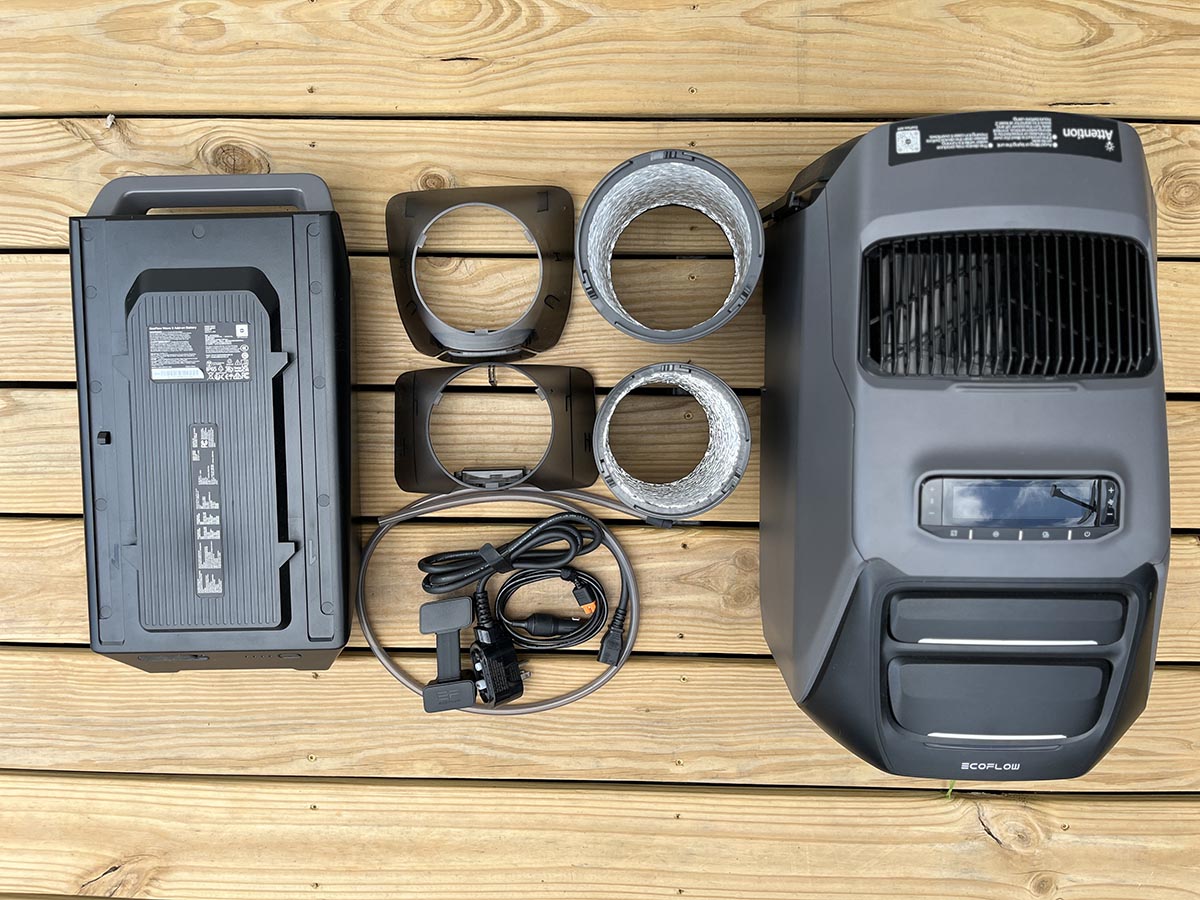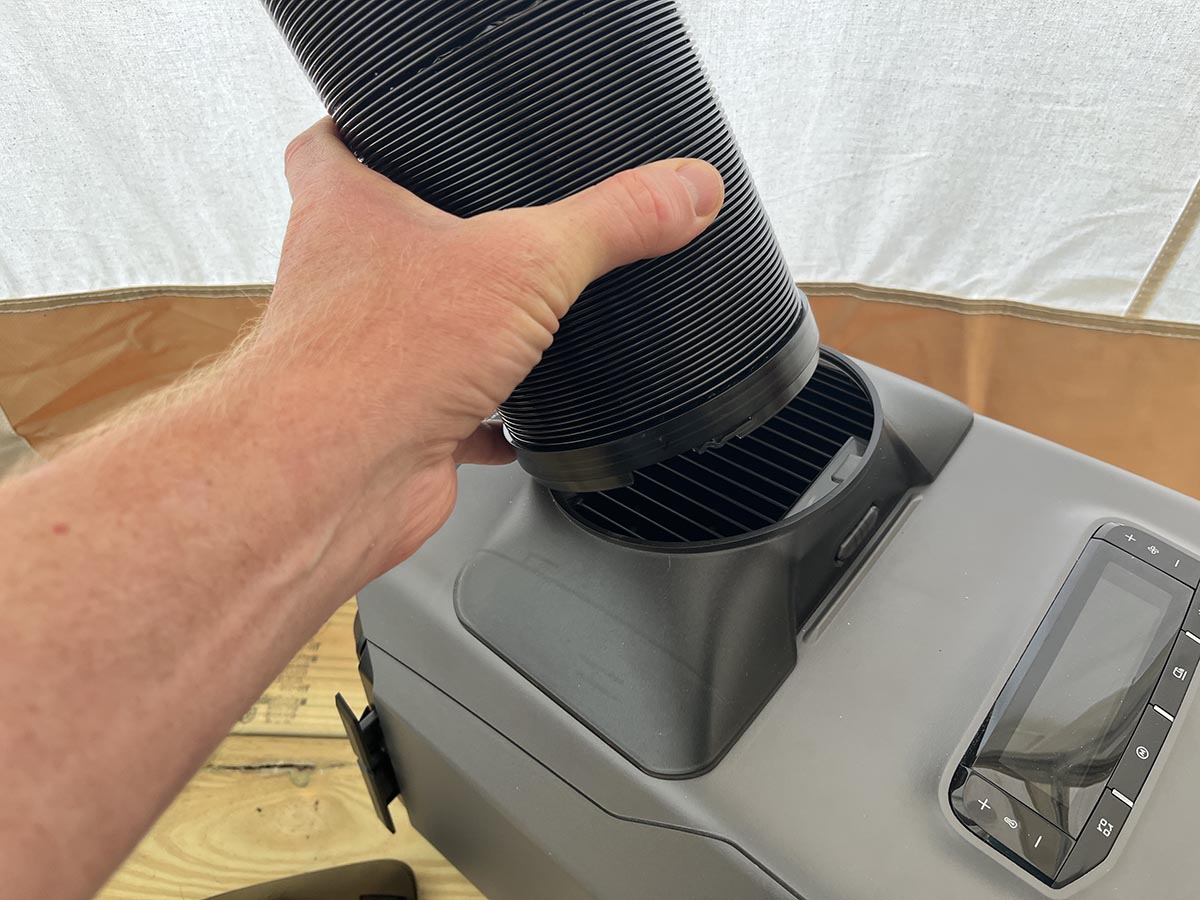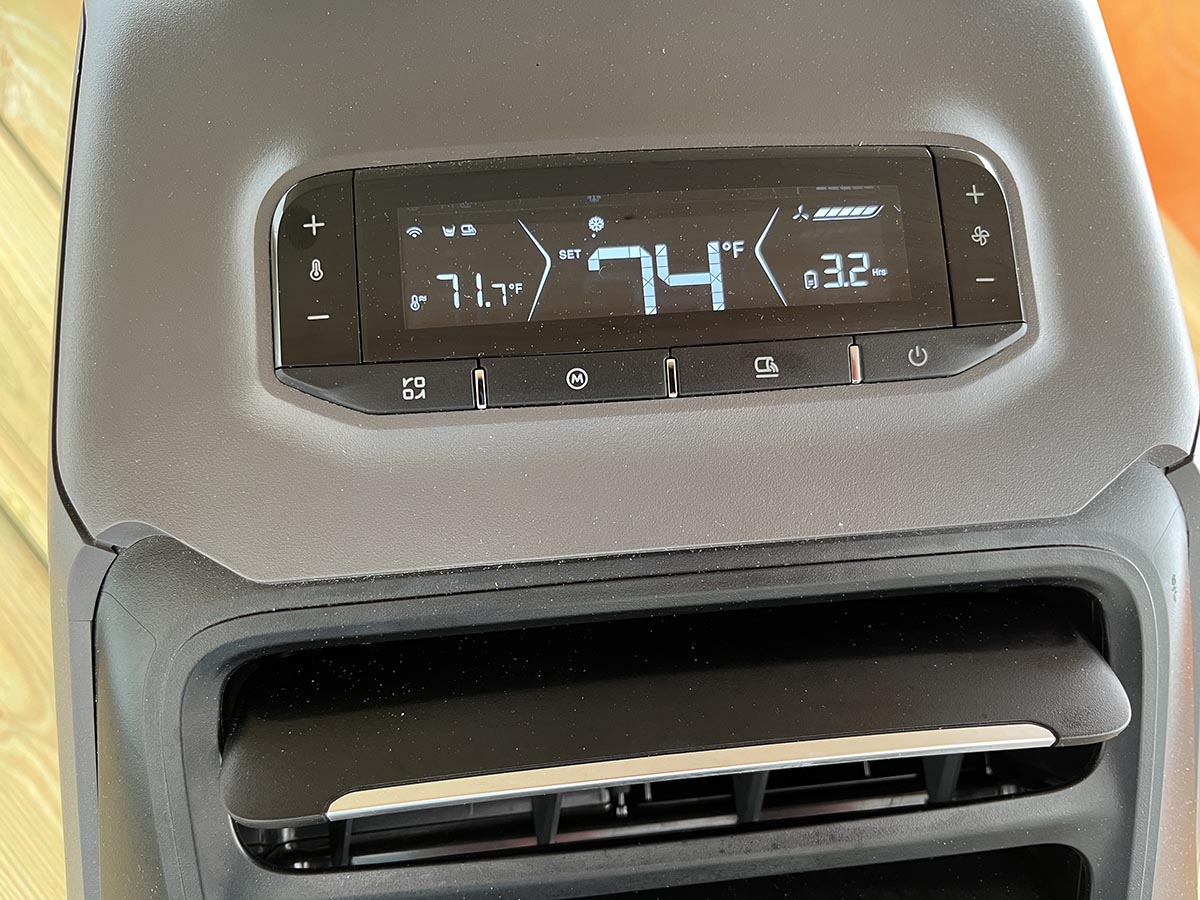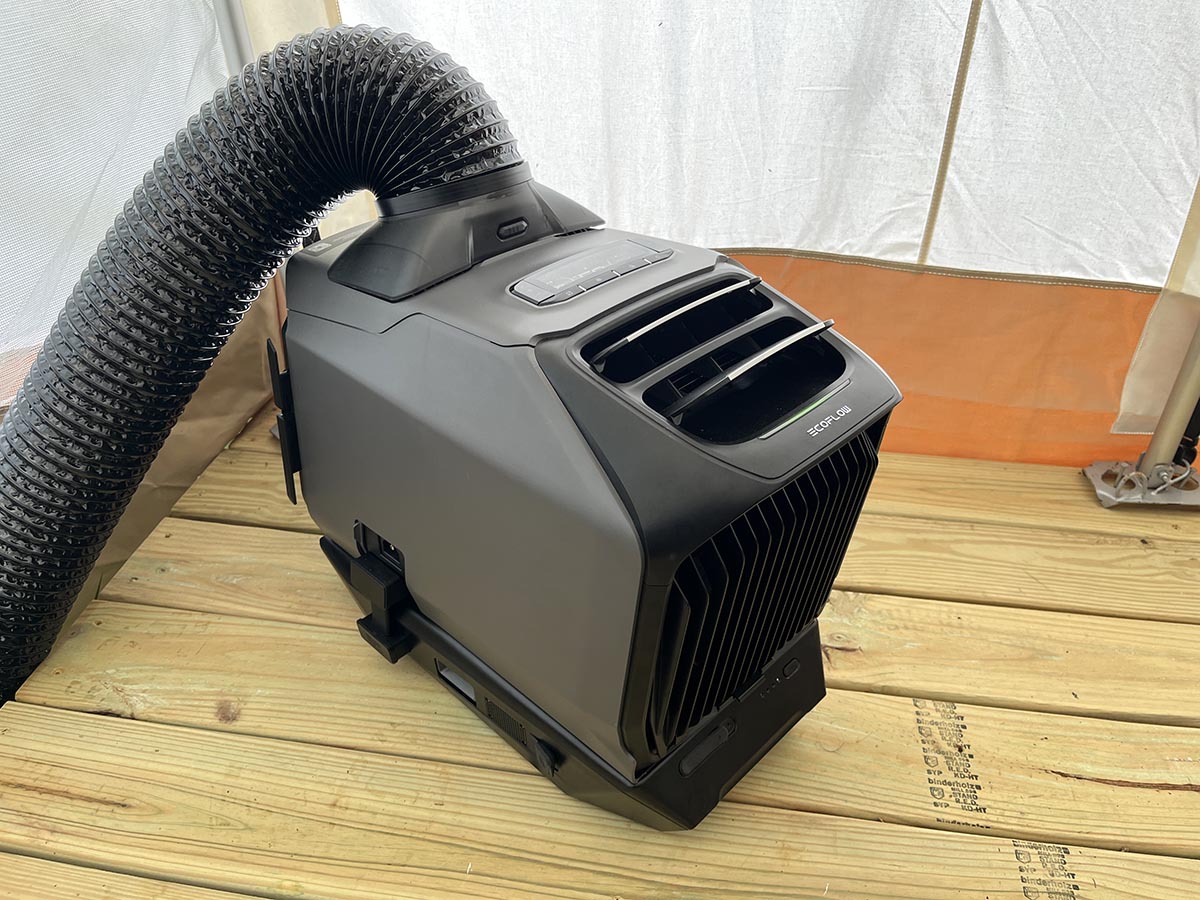

We may earn revenue from the products available on this page and participate in affiliate programs. Learn More ›
EcoFlow, the brand best known for its Delta and River series of portable power stations, just released its third-generation battery-powered air conditioner, the EcoFlow Wave 3, and I got an opportunity to try it out. Think of this device more like a heat pump in that it includes both cooling and heating modes, along with a separate dehumidification mode. The brand claims it can lower the temperature by 15 degrees in 15 minutes in rooms up to 183 square feet. Most shoppers are probably thinking of buying a battery-powered portable air conditioner for camping, but I had another use in mind. For this review, I tested its cooling ability in my 120-square-foot temporary workshop, which happens to be a 10-by-12-foot canvas wall tent.
EcoFlow Wave 3: At a Glance
Our rating: 4.8/5
| EcoFlow Wave 3 Specs | |
| Cooling capacity | 6,100 BTU |
| Heating capacity | 6,800 BTU |
| Max air volume | 330 m3/hour |
| Dimensions | 13.2 inches high by 11.7 inches wide by 20.4 inches deep |
| Weight | 33.7 pounds |
Testing the EcoFlow Wave 3

We tested this unit for a week in late April, when we were experiencing daytime highs in the mid-80s and lows in the low 60s in my part of Georgia. I wanted to set up the test in a realistic way to showcase the Wave 3’s strengths and reveal potential weaknesses. Cooling a canvas tent on a hot day is challenging enough, so I set up in a location with very little direct sunlight to help preserve battery life. The tent sat on a wooden deck/platform with spaces between the boards and around the base of the tent where cool air would be continuously lost. I did not alter the setup for testing, but for long-term use, I might install the vinyl floor that came with the tent.
This device offers multiple functions, not just cooling, but I decided to focus on cooling since that is my primary need. The first test focused on how quickly it worked. I set a target temperature 20 degrees below the outside air temperature and used a digital gauge to track temperature and humidity changes in 15-minute increments while it cooled the space for an hour. The second test evaluated consistency. I set target temperatures 15 degrees lower than the outside air temperature and used the temperature/humidity gauge to check conditions at 30-minute intervals over 5-hour periods.
| What We Like | What We Don’t Like |
| Heating, cooling, and dehumidification with a single unit | Less effective in unsealed, uninsulated areas |
| Works with a variety of power sources | Shorter battery life in heating mode |
| Advanced mobile app controls | |
| Great for moderate heating and cooling needs in tents, vans, or small rooms |
Features: 5/5
As the name suggests, the EcoFlow Wave 3 is the third generation in the Wave lineage, designed to heat, cool, or dehumidify spaces up to 180 square feet. Compared to the Wave 2, it packs 1,000 BTU more cooling power, 700 BTU more heating power, and is capable of cooling spaces up to one-third larger. This latest generation also comes with a lithium iron phosphate (LFP) battery that should provide about 5 times the working life span compared with Wave 2’s battery chemistry. As for new operational features, the Wave 3 has added auto and dehumidification functions, plus pet care mode and drain alert in the mobile app.
The Wave 3’s automatic function allows it to stay in a standby state until the temperature drops below the set temperature. Then, it automatically switches to heating. Similarly, the pet care setting automatically starts cooling when the conditions exceed the target temperature. For added comfort, the new dehumidification function makes the ambient temperature more comfortable by reducing the sticky, muggy feeling. To keep things running smoothly, the app now includes a water drain notification when the tank nears full.
Portability: 5/5

The most important characteristic of this device is its portability. The Wave 3 measures 13.2 inches high, 11.7 inches wide, and 20.4 inches deep, or about the size of a small cooler. It weighs a manageable 33.7 pounds and has built-in holds at the front and rear. Whether you need to load it in the trunk of a car, the back of a van, or in a truck tool box, it’s fairly easy to transport. Just don’t forget the power supply. If you buy the optional add-on battery, it weighs about 20 pounds. Other options for even longer runtimes include any of the Delta series portable power stations. I recommend getting a storage tote for the vent hoses and power cords that come with it.
Setup: 5/5
The Wave 3 is as close to plug-and-play as possible. It only took about 5 minutes to set it up, connect to the EcoFlow app on my phone, and start cooling my space. Depending on the space and your specific climate control needs, the unit can be placed inside or outside the area to be heated or cooled. You can use the vent hoses to create a loop of warm air or cool air into or out of the space without creating negative or positive air pressure. For the test, I attached the hoses to the warm air intake and supply outlets and routed them beneath a tent wall to the outside.
I received the 1,024-watt optional add-on battery to power my Wave 3, but it also works with EcoFlow’s Delta series power station, and battery life can be extended with the addition of a solar panel. The built-in charge controller supports simultaneous charging and use. For heavier use, such as daytime cooling in the summer, you’ll need the extra capacity—more on that later. Suffice it to say that this unit works with a wide range of power supply options.
Performance: 4/5

I started the cooling test at about 3 p.m., when the temperature was 82.1 degrees Fahrenheit with 67 percent relative humidity. The unit’s output was strong and felt cold (better when I removed the vent hose connector). The cold air outlet consistently read between 60 and 62 degrees, but outside air intrusion proved to be a barrier to efficient cooling. At the 15-minute check-in, the temperature had dropped to 80.4 degrees, and the humidity was down to 63 percent. The -1.7 degree change in that first 15-minute segment was the steepest temperature drop of the test.
Check-ins at 30, 45, and 60 minutes produced temperature readings of 79.5 (-0.9 degrees), 78.1 (-1.4 degrees), and 77.6 degrees (-0.5 degrees), respectively, and humidity levels of 61, 61, and 62 percent. When the test was over at 4 p.m., the total changes were -4.5 degrees and -5 percent relative humidity.
For the second test, I installed the tent’s vinyl floor over the deck, which also made a nice seal around the perimeter where it met the sidewalls. I used a tarp to block the air gap around the vent hoses. To ensure adequate power for the duration of the test, I replaced the add-on battery that came in my Wave 3 bundle with my EcoFlow Delta Pro 3 portable power station, which was connected to a 400-watt solar panel. The extra preparation paid off. With an outside temperature that ranged from 76 to 84 degrees Fahrenheit during the 5-hour test, the Wave 3 was able to maintain an inside temperature within 3 degrees of my 70-degree target temperature.
Added functionality at a very competitive price

The new EcoFlow Wave 3 has the same $1,299 regular price as its predecessor, but neither one is actually selling for that price. Both Amazon and the EcoFlow online store are currently selling the Wave 3 for $1,099. Compare that to the new Zero Breeze Mark 3 air conditioner, which has a $1,399 MSRP, and doesn’t seem to be discounted anywhere yet. Sure, the Wave 3 weighs about 15 pounds more, but it outperforms the newest Zero Breeze model in terms of cooling BTUs. Plus, it offers the heating and dehumidification functions not found on the Mark 3. Both are good products, but EcoFlow gives you more functionality for your money.
Buy the EcoFlow Wave 3 at:
Product Comparisons
| EcoFlow Wave 3 | Zero Breeze Mark 3 AC | BougeRV Portable Air Conditioner | |
| Cooling capacity | 6,100 BTU | 5,280 BTU | 2,899 BTU |
| Heating capacity | 6,800 BTU | 5,800 BTU | NA |
| Maximum cooling area | 180 square feet | 150 square feet | 54 square feet |
| Dimensions | 13.2 inches high by 11.7 inches wide by 20.4 inches deep | 12 inches high by 10 inches wide by 22 inches deep | 9 inches high by 23 inches wide by 13.3 inches deep |
| Weight | 33.7 pounds | 22 pounds | 23.2 pounds |
| Regular Price | $1,299.00 | $1,399.99 | $899.00 |
So, is the EcoFlow Wave 3 right for you?
High humidity works against efficient cooling. That’s why HVAC pros recommend targeting home humidity levels of 40 to 50 percent in the summer. The EcoFlow Wave 3 is the only battery-powered air conditioner we know of with a dehumidifier function for times when the temperature is otherwise comfortable. That’s pretty great for those of us in humid regions, like the southeastern United States. That being said, the Wave 3 is best suited for a tightly closed space. I did not alter my setup for my rapid cooling test, and the warm, wet ambient air flowed through fairly easily. The experience was much better after I closed the gaps.
If you are considering a portable air conditioner for tent camping or RVing, this one is a great option. It’s perfect for creating comfortable sleep conditions in a small space; in fact, that is what it was designed to do. It’s easy to pack, easy to set up, and offers three-way functionality for spring, summer, and fall outings. As for my idea of using it to make my work area more comfortable during 95-degree summer afternoons: maybe not. This unit does not have the cooling power to keep up with demand where the doors are frequently opened and closed to extreme temperatures.
Meet the Tester
Mark Wolfe is a writer, product tester, and avid DIYer. When he isn’t writing, he spends his time upgrading, repairing, and replacing anything and everything in his home, yard, and garden. He reviews tools, lawn care and home repair products, and outdoor living goods.
